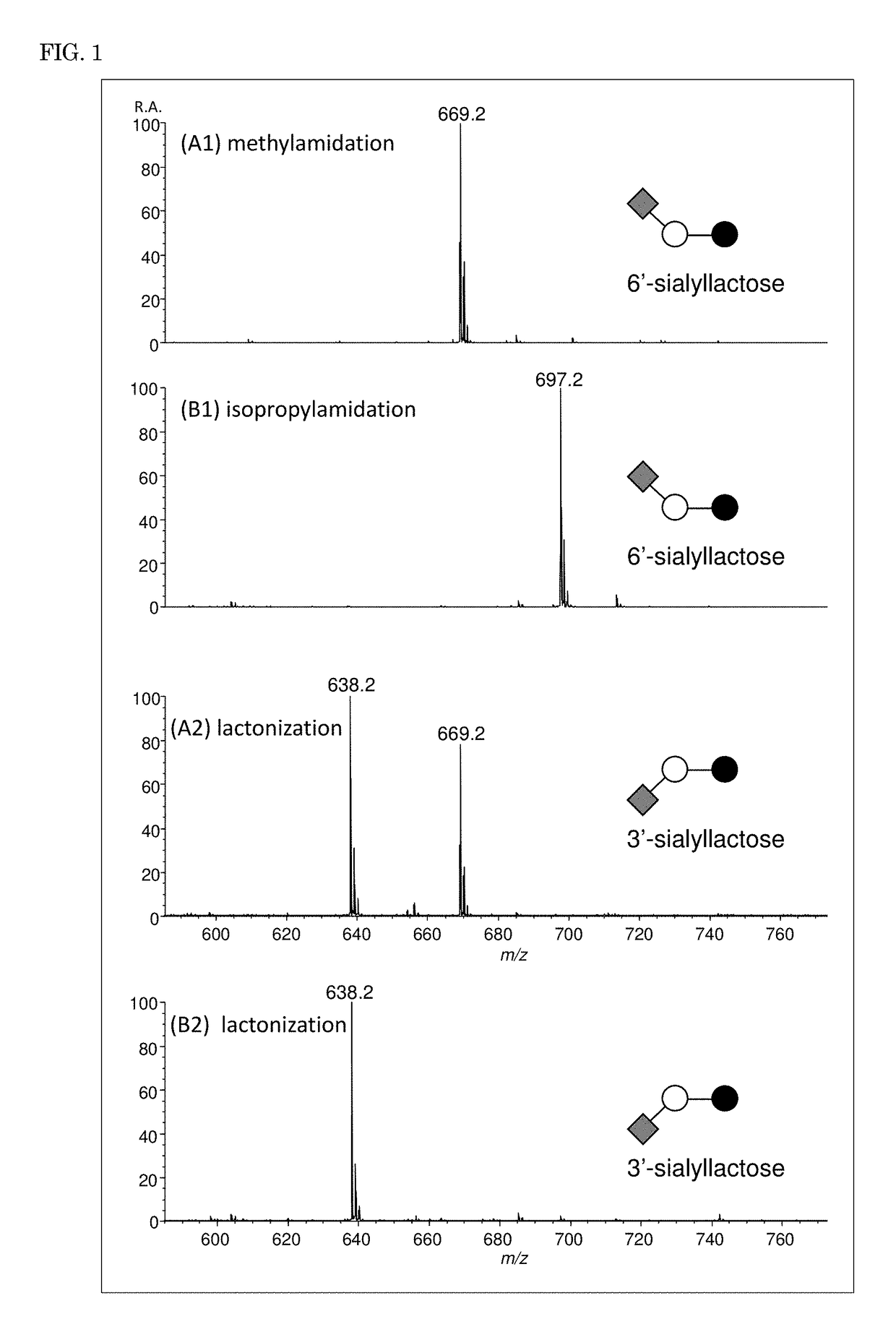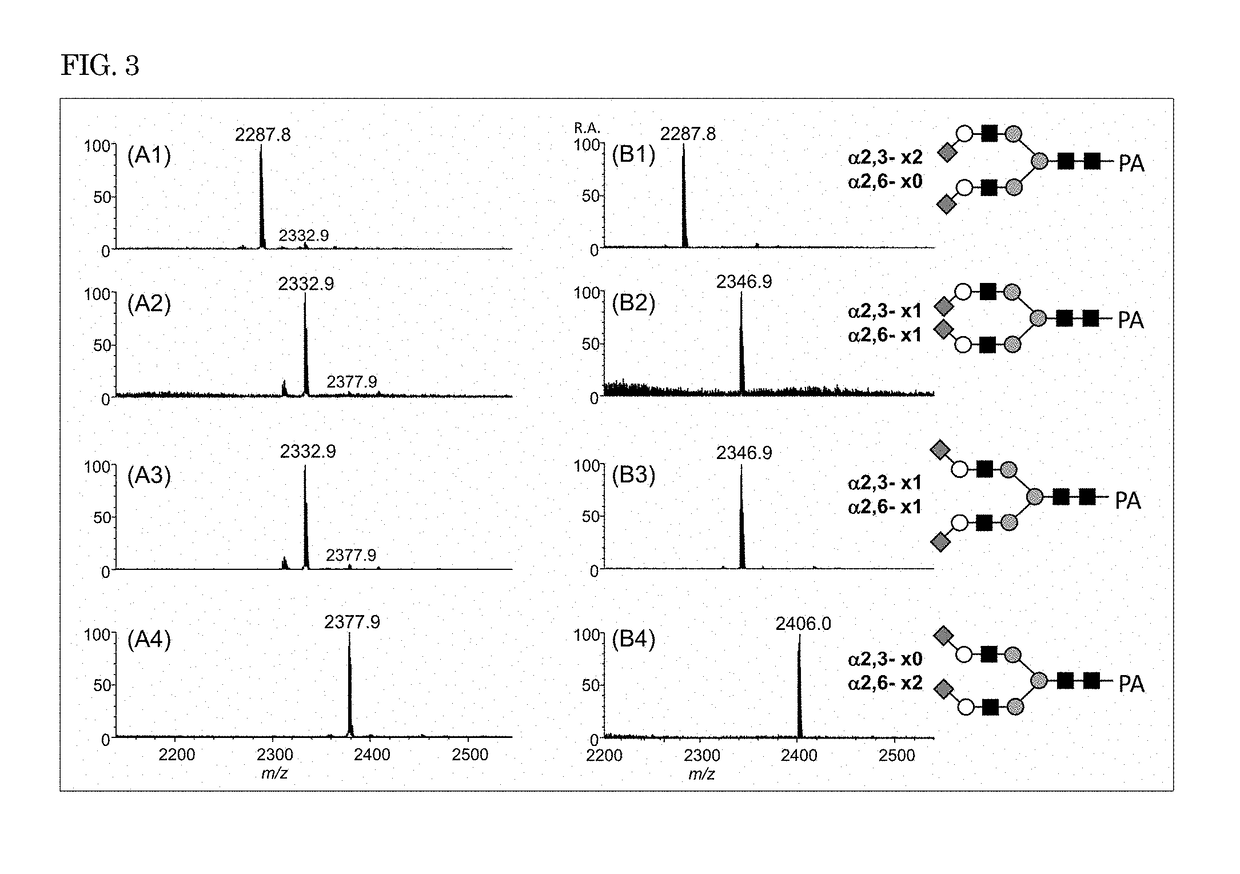Method of preparing sample for analysis and analysis method
a sample and analysis technology, applied in the field of preparing a sample for analysis and an analysis method, can solve the problems of easy decomposition or separation of sugar chains
- Summary
- Abstract
- Description
- Claims
- Application Information
AI Technical Summary
Benefits of technology
Problems solved by technology
Method used
Image
Examples
example 1
[Example 1] Modification of Sialyllactose
[0105]In Example 1, 3′-sialyllactose was used as a free sugar chain sample having α2,3-linked sialic acid, and 6′-sialyllactose was used as a free sugar chain sample having α2,6-linked sialic acid to examine the effects of the type of amine used and reaction conditions on modification.
[0106](Preparation of Sugar Chain Sample)
[0107]3′-sialyllactose and 6′-sialyllactose (both of which were purchased from Tokyo Chemical Industry Co., Ltd.) were each dissolved in water, dispensed, centrifugally concentrated (SpeedVac) to remove the solvent, and dried.
[0108](Reaction with Amine)
[0109]Solutions were prepared by dissolving various amine hydrochlorides (ammonium hydrochloride, methylamine hydrochloride, ethylamine hydrochloride, dimethylamine hydrochloride, propylamine hydrochloride, isopropylamine hydrochloride, and butylamine hydrochloride) in DMSO (amine hydrochloride concentration: 1 M to 4 M), and 10 μL of each of the solutions was added to a su...
example 2
[Example 2] Examination of Reaction Conditions
[0119]In Example 2, sialyllactose was used as a sample, and reacted with an amine in the presence of a dehydration-condensation agent in the same manner as in Example 1. The effects of reaction conditions on modification were examined by changing the concentration of an amine hydrochloride, the concentration of a dehydration-condensation agent, and the temperature during reaction.
[0120](Examination of Amine Concentration)
[0121]A reaction between sialyllactose and an amine was performed in the presence of a dehydration-condensation agent (DIC and HOBO in the same manner as in Example 1 except that isopropylamine hydrochloride was used as the amine hydrochloride, and the concentration of isopropylamine hydrochloride during the reaction was varied within the range of 0.5 M to 4.5 M (concentration at the time of preparation of DMSO solution: 1 M to 9 M). Each reaction solution was purified and subjected to mass spectrometry in positive ion m...
example 3
[Example 3] Modification of Branched Sugar Chains Having Two or More Sialic Acid Residues
[0131]In Example 3, four biantennary pyridylaminated (PA) sugar chains having two sialic acid residues whose linkage types were known were used as samples. Each of the samples was modified by reaction with an amino hydrochloride in the presence of a dehydration-condensation agent (DIC and HOBt), and the obtained reaction solution was purified and subjected to mass spectrometry in positive ion mode in the same manner as in Example 1.
[0132]Positive ion mass spectra of the samples modified with ethylamine hydrochloride as the amine hydrochloride are shown in FIGS. 3(A1) to 3(A4). Positive ion mass spectra of the samples modified with isopropylamine hydrochloride as the amine hydrochloride are shown in FIGS. 3(B1) to 3(B4).
[0133]In the mass spectra of all the four sugar chains before modification, peaks were observed at the same m / z. In contrast, when the sugar chains were reacted with an amine hydr...
PUM
| Property | Measurement | Unit |
|---|---|---|
| temperature | aaaaa | aaaaa |
| diameter | aaaaa | aaaaa |
| temperature | aaaaa | aaaaa |
Abstract
Description
Claims
Application Information
 Login to View More
Login to View More - R&D
- Intellectual Property
- Life Sciences
- Materials
- Tech Scout
- Unparalleled Data Quality
- Higher Quality Content
- 60% Fewer Hallucinations
Browse by: Latest US Patents, China's latest patents, Technical Efficacy Thesaurus, Application Domain, Technology Topic, Popular Technical Reports.
© 2025 PatSnap. All rights reserved.Legal|Privacy policy|Modern Slavery Act Transparency Statement|Sitemap|About US| Contact US: help@patsnap.com



